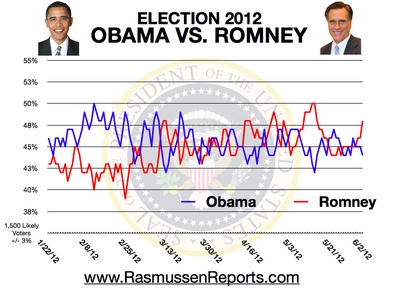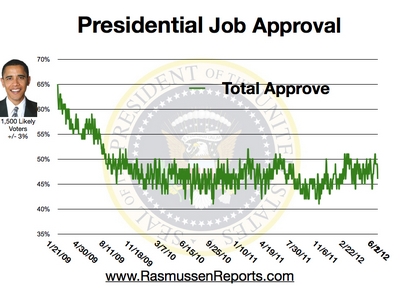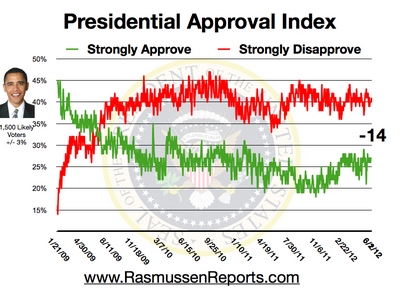
Daily Presidential Tracking Poll
Saturday, June 02, 2012
The Rasmussen Reports daily Presidential Tracking Poll for Saturday shows Mitt Romney picking up 48% of the vote, while President Obama attracts 44%. Four percent (4%) prefer some other candidate, and five percent (5%) are undecided.
Matchup results are updated daily at 9:30 a.m. Eastern (sign up for free daily e-mail update ).
This is the first time either candidate has been ahead by more than two points since President Obama held a three-point edge on May 21. As with all such changes, it remains to be seen whether these new numbers reflect a lasting change in the race or are merely statistical noise. See tracking history .
Following yesterday's disappointing jobs report, consumer confidence fell five points overnight . It often takes up to a week before the impact of a jobs report is fully measured.
Among investors, the impact was especially dramatic. On Friday, just before the jobs report, investors were almost evenly divided as to their own financial trends--35% said things were getting better, while 39% said the opposite. On Saturday morning, just 30% of investors believe their finances are getting better, while 43% think they are getting worse. The stock market had a terrible month of May and the Dow fell by 275 points following the jobs report.
These results emphasize the key observation from Scott Rasmussen's weekly newspaper column: "The underlying reality is that Team Obama has a difficult hand to play. The economy matters more than campaign tactics, and the indicators at the moment are mixed at best."
Michael Barone suggests that the Obama campaign might be fooling itself.
Check out our review of last week's key polls to see "What They Told Us."

A president's Job Approval rating is one of the best indicators for assessing his chances of reelection. Typically, the president's Job Approval rating on Election Day will be close to the share of the vote he receives. Currently, 46% of voters say they at least somewhat approve of the president's job performance. Fifty-three percent (53%) at least somewhat disapprove ( see trends ).
Approval of the president is now the lowest in three weeks. For all of 2012, his total approval has stayed between 44% and 51%.
When tracking President Obama's job approval on a daily basis, people sometimes get so caught up in the day-to-day fluctuations that they miss the bigger picture. To look at the longer-term trends, Rasmussen Reports compiles the numbers on a full-month basis. For the full month of May, the president's total Job Approval rating was at 49% , up two points from April. However, it is within the narrow range of 47% to 49% that his approval ratings have occupied since the beginning of 2012.
For the first time in five-and-a-half years of regular tracking, half of voters now trust Republicans more than Democrats when it comes to the economy. The GOP now has a 50% to 39% advantage on the economy. And, of course, that's the issue voters rate by far as most important this election season .
Just 38% believe the president has done a good or excellent job on the economy .
The chairman of the Federal Communications Commission has proposed usage-based Internet pricing rather than flat fee service. But just 15% voters think the government should decide the pricing issue . Seventy-four percent (74%) think individual Internet-providing companies should be allowed to decide pricing for themselves.
If you'd like Scott Rasmussen to speak to your organization, meeting, or conference, please contact Premiere Speakers. The Wall Street Journal has called him "America's leading insurgent pollster," and The Washington Post says Scott is a "driving force in American politics."
To get a sense of longer-term Job Approval trends for the president, Rasmussen Reports also compiles our tracking data on a full month-by-month basis.

Intensity of support or opposition can have an impact on campaigns. Currently, 27% of the nation's voters Strongly Approve of the way that Obama is performing his role as president. Forty-one percent (41%) Strongly Disapprove, giving him a Presidential Approval Index rating of -14 ( see trends ).
During midterm elections, intensity of support can have a tremendous impact on turnout. That was demonstrated in 2010 when Republicans and unaffiliated voters turned out in large numbers to express opposition to the Obama administration's policies. However, in presidential election years, there is a smaller impact on turnout.
(More Below)

Rasmussen Reports is a media company whose work is followed by millions on a wide variety of platforms. We regularly release our results at RasmussenReports.com , through a daily email newsletter , a nationally syndicated radio news service , an online video service and a weekly newspaper column distributed by Creators Syndicate . A nationally syndicated TV show-- What America Thinks --is scheduled for launch in September 2012.
Our firm has been a pioneer in the use of automated telephone polling techniques, but many other firms still utilize their own operator-assisted technology ( see methodology ). Pollsters for Presidents Jimmy Carter and Bill Clinton have cited our " unchallenged record for both integrity and accuracy ."
During Election 2008, Rasmussen Reports projected that Barack Obama would defeat John McCain by a 52% to 46% margin. Obama was 53% to 46%. In 2004, Rasmussen Reports was the only firm to project the vote totals for both candidates within half a percentage point. Learn more about the Rasmussen Reports track record over the years .
Daily tracking results are collected via telephone surveys of 500 likely voters per night and reported on a three-day rolling average basis. To reach those who have abandoned traditional landline telephones, Rasmussen Reports uses an online survey tool to interview randomly selected participants from a demographically diverse panel. The margin of sampling error for the full sample of 1,500 Likely Voters is +/- 3 percentage points with a 95% level of confidence. Results are also compiled on a full-week basis and crosstabs for full-week results are available for Platinum Members .
Like all organizations that conduct public opinion polls, Rasmussen Reports weights its data to reflect the population at large ( see methodology ). It is important to remember that the Rasmussen Reports job approval ratings are based upon a sample of likely voters. Some other firms base their approval ratings on samples of all adults. Obama's numbers are almost always several points higher in a poll of adults rather than likely voters. That's because some of the president's most enthusiastic supporters, such as young adults, are less likely to turn out to vote.
Among other targets, Rasmussen Reports weights data by political party affiliation using a dynamic weighting process. While partisan affiliation is generally quite stable over time, there are a fair number of people who waver between allegiance to a particular party or independent status. Our baseline targets are established based upon separate survey interviews with a sample of adults nationwide completed during the preceding three months (a total of 45,000 interviews) and targets are updated monthly. Currently, the baseline targets for the adult population are 35.7% Republicans, 33.4% Democrats, and 30.8% unaffiliated. Likely voter samples typically show a slightly larger advantage for the Republicans.
